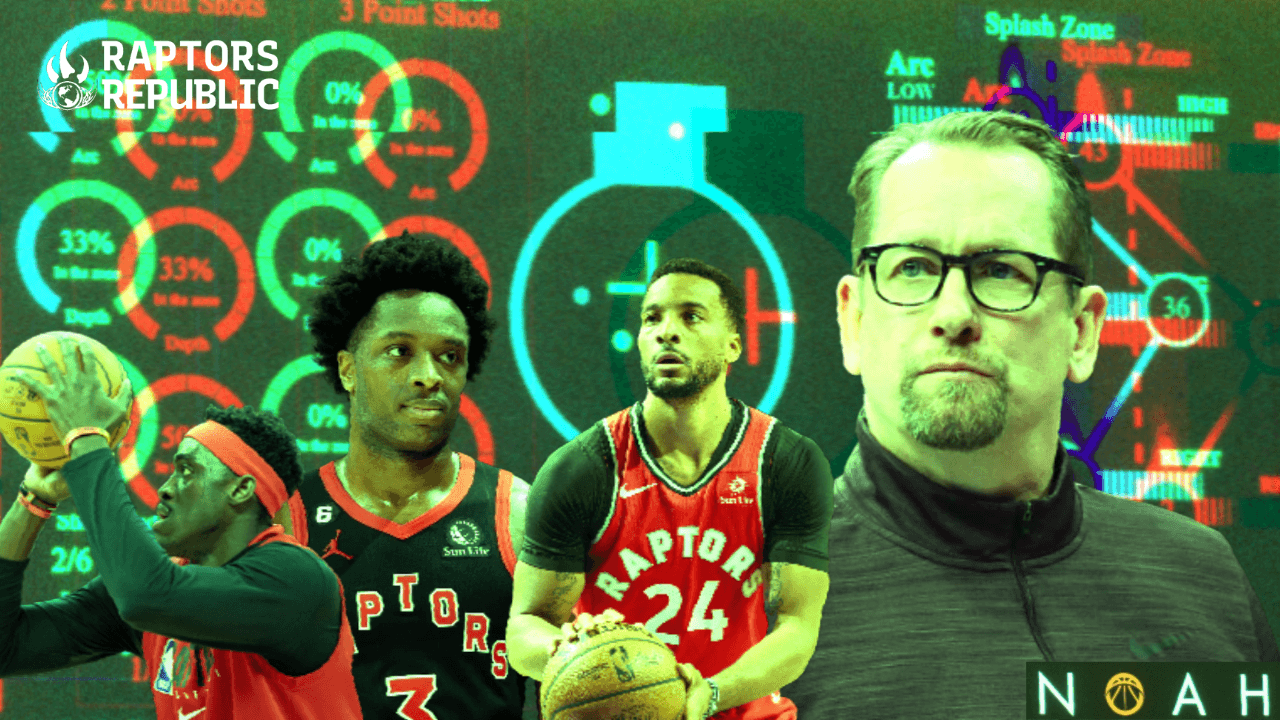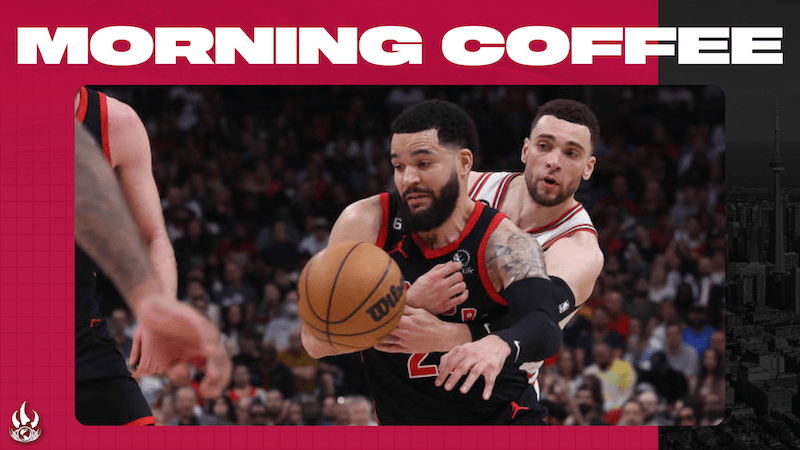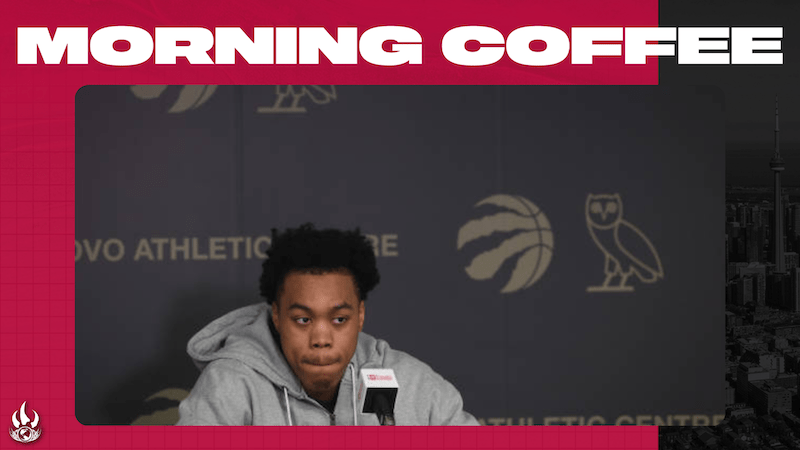Basketball games are rarely ever lost in one place, and one place only, but the Raptors play-in game really was lost at the free throw line. The Raptors allowed some baskets late, but the gameplan was good throughout, and without the glut of Raptors live-ball turnovers in the second half the Bulls likely would’ve finished the game under 100 points. The Raptors produced the looks they needed to, hit their season average from downtown (33%), and were an average night at the line away from a comfortable win. If this team was Giannis Antetokounmpo from the line, instead of Shaquille O’Neal, they win the game. They shot 78-percent on the season, by the way.
Even then, it was the 9/10 play-in game.
The N.O.A.H. Board. Nick Nurse’s ‘The Gold Book of Shooting’. The special basketball: The Pill. The long legacy of the Raptors shooting development. A freakish performance from the line doesn’t mean it was all overstated, but it provides the impetus to see if it was.
Why did the Raptors — as talent on the team, some developed there, some not, left — cascade farther and farther down the major shooting categories, if they could simply develop shooters?
2018-19: 6th in 3-point percentage. 3rd in free throw percentage.
2019-20: 5th in 3-point percentage. 6th in free throw percentage.
2020-21: 15th in 3-point percentage. 4th in free throw percentage.
2021-22: 20th in 3-point percentage. 23rd in free throw percentage.
2022-23: 28th in 3-point percentage. 17th in free throw percentage.
I want to review the seminal moments that created the narrative that Toronto was the home of shooting development. Let’s scan for things that are out of the ordinary.
Pascal Siakam’s corner threes, and 59 games of pull-up shooting.
A really important and little-discussed aspect of Siakam’s shooting development: he was one of college basketball’s truly elite, long mid-range shooters in his time at New Mexico State. He shot 169-403 (42%) on them in his 2 year college career. It’s true that he wasn’t discussed as a shooter when he got drafted, or in the early part of his career, but Siakam’s shot chart and points of emphasis offensively seem clearly built off of his elite movement skills, touch at the rim, and a mid-range prowess – which there were clear indicators for in his college tape.
Since his 3-point attempts stopped being almost exclusively, set, corner looks, he’s shot 33-percent on 1116 attempts. Luckily, he’s an elite passer, driver, and an excellent worker in the mid-range. He’s an All-Star, at the very least. But, it’s become increasingly clear that many teams and players in the NBA are capable of sitting down in the corner and hitting a shot there. This development isn’t unique to the Raptors at all.
What made it seem like Siakam had transcended past all that, were his 59 games in the 2019-20 season where he shot 34-percent on his pull-up threes. Not only was he shooting it well, but he was taking 2.5 pull-up triples a game, which is a massive amount for a player who has only taken 3.6 threes a game over his last 139 contests. 34-percent on 2.5 a game are truly elite numbers for a wing in that category. If that held steady, no team would ever shoot the gap on his pin-downs, or go under in their pick and roll coverage.
It was an amazing stretch of pull-up shooting, but he’s never come close to emulating that again. In 2020-21: 23-percent on 1 pull-up a game. 2021-22: 25-percent on .5 pull-ups a game. In 2022-23: 27-percent on 1 pull-up a game. Technically trending up, but on very small volume.
Siakam’s ascent to stardom, coupled with a really great run of shooting, helped bolster the lore. Everyone loves to see role players work on their craft and add a jumper, but a star adding something like that on massive volume? That moves mountains. Only, it was a blip.
Norman Powell, the incredible outlier
The only movement shooter developed by the Raptors, and oh my days is he good. He came into the league and immediately showed that he could hit set 3-point shots and doing so at a pretty insane clip of 41-percent in his rookie season. That in and of itself isn’t particularly unlikely, but the fact that he ended up becoming an unconscionably good shooter coming off pin-downs, the wide-pin, and flares? Ridiculous.
After struggling in his 2nd and 3rd seasons from downtown, Powell flipped the page and flat out became one of the league’s best 3-point shooters. He’s hit over 40-percent over his last 5 years and spanning 1399 attempts. And again, as a very versatile shooter who you can use endlessly in set pieces to score points or open up your primary scorers. In his last 3 seasons he’s ranged from 33-percent to 37-percent on his pull-up 3’s and no lower.
A fun quote from 2015 and a piece that Blake Murphy wrote after Norm Powell’s first few Summer League games with the Raptors:
“I thought he was worth a second-round flier on the chance he develops an outside shot, something he flashed early in his senior season but seemed to lose as the year wore on. The three-year shooting sample is large enough and poor enough to be worrisome, and the Raptors know all too well how tough it can be to give wings who can’t space the floor heavy run.”
Blake Murphy, 2015
“The Raptors know all too well how tough it can be to give wings who can’t space the floor heavy run.” All these years later, as shooting became even more important, they leaned harder into poor spacing. Pretty wild.
All this to say, Blake has been a very good analyst for a long time, is a basketball sicko (especially for the UCLA), was really high on Powell, and even he kind of threw his hands up about his shooting.
If I were the Raptors, Powell would be who I pointed to as the gold standard. Because, my god, his shooting development is absolutely insane. An imperfect, but fine, comparison as far as shooting talent goes would probably be Donovan Mitchell. It’s not a perfect comparison, but relative to their college numbers, both have scaled up similarly. Mitchell on higher volume and a little more efficiency in college, now on higher volume and slightly less efficiency. Powell is the hyper-efficient play finisher, Mitchell is the offensive engine.
Ready-made O.G., and a lack of diverse shooting
O.G. Anunoby can shoot the hell out of the basketball, and when you consider that he has the defensive talent to contend for a DPOY, he can really shoot the hell out of the basketball. The sexy blogger pick, who fell out of the top-10 because of a torn ACL, not because of a lack of tools. He came directly into the NBA and shot 37-percent from three. Much better than the 31-percent he shot from three in his last season at Indiana, but was his shooting development on a super highway somehow? Anunoby was rehabbing a torn ACL that he — incredibly, by the way — returned from in less than 10 months, playing opening night of his rookie season.
This wasn’t even a guy that the Raptors immediately popped in the gym and put through the shooting motions. He was doing extensive rehab on his knee. He walked into the NBA, and shot the ball.
It’s become really good since then, too. But, Anunoby is very much a set shooter at this point in his career. Any foray into movement shooting or pull-up shooting completely disassembles his posterior chain and his shot becomes truncated and as low-efficiency as they come. He doesn’t have to be a movement shooter, though. If that day comes, fantastic, but he’s already incredibly good. Any other developments are icing on the cake.
But the question is, of course: Why aren’t the Celtics considered the land of shooting development for Jayson Tatum, Jaylen Brown, Terry Rozier, Marcus Smart, Grant Williams? When those players range from high volume/high versatility/decent efficiency to low volume/low versatility/high efficiency the same way some Raptors have? Who is taking credit for Jerami Grant’s shooting development, who went from 30-percent on miniscule volume in college, for example? Or De’Anthony Melton, who has shot 39-percent over his last 1000 three-pointers after shooting 28-percent in college. Those players, typically, get all the credit – as they should.
The Raptors have become, objectively, one of the worst shooting teams in the league. I’ve been lucky to talk to a lot of professional scouts who work anywhere from agencies to NBA teams, and all of them look harder at a players tools and capacity or potential to develop them than they do at where they are getting drafted. Where you get drafted is important, of course, and especially when you consider what type of playtime will be awarded. But, playtime is a playground for players to work on skills they’re developing. It’s typically less about a certain organization having a trademark on being able to develop that one thing – especially when there’s not much proof of concept.
Siakam was drafted because of his elite and wildly intriguing movement skills on both ends of the floor, and the Raptors no doubt found it interesting that he shot pretty well from the line and astonishingly well from the mid-range. Anunoby was a top-10 pick, easily, who fell to them because of injury, and good on them for pulling the trigger. Fred VanVleet forced their hand over and over again by being that good defensively, that good offensively and eventually getting the minutes to flash his wonderfully odd side-spinning jumper that had been a verifiable heat-pump since Wichita State. Norman Powell, well damn, he developed into an insane shooter from a non-shooter, it’s true.
But, does that make the Raptors the home of shooting development? In 2018-19 the bulk of the Raptors shooting prowess came from players who had already established their three-point prowess elsewhere, like Kyle Lowry, Danny Green, and Kawhi Leonard. Anunoby, VanVleet, Siakam, they filled out the back end, taking the easier looks.
2019-20, the team of destiny
2019-20 is the year. Outside of Kyle Lowry, it’s a whole bunch of Raptors draft picks raining hell fire from downtown. Two undrafted players, the 23rd pick of 2017, the 27th pick of 2016, and the 46th pick of 2015 were amassing roughly 25 3-point attempts per game and converting at roughly 39-percent. That is insane. The team that was so much more than the sum of its parts, and largely because it had a truly great makeup. A star-ascendant wing in Siakam to collapse defenses who was on the heater of his lifetime from downtown. A still, wildly underrated Kyle Lowry to organize offense and provide the best shots and shot chart anyone could ask for. VanVleet and Powell as flamethrowers off-ball who could occupy the weak-side and kill with their movement shooting. Marc Gasol as a genius connector who could make threes of his own. This team played beautiful basketball and it set a standard that just can’t really be met year to year. Everyone was underrated at that point in time, and they were all so, so good.
As Lowry, one of the most underrated guards of all time (really, REALLY!) lost a bit of a step and relinquished his grip hold on the offense; and Siakam’s miraculous heater ran empty, the Raptors offense changed. And while it changed, the Raptors signed a lot of limited offensive players who would go on to underwhelm because the Raptors couldn’t recreate 2019-20 environment where everyone who touched the floor was made into a quality role player.
The team’s halfcourt offense cratered in the following years, and largely because of roster imbalance and the fact that they couldn’t shoot well. This led to more aggressive defensive schemes to promote transition offense to avoid the halfcourt. This led to more limited shooters joining the roster. All of this was undergirded by the assumption that the Raptors could develop anyone into a serviceable shooter. They haven’t.
Now, why do I stress that the players get the credit for the development instead of the team? Well, development is a black box in a lot of ways, and obviously the players have the tools, the capacity, and they have to do the work. Even if there are good development coaches, they are only there to help. When it’s not always clear why or how something is happening, messaging becomes extremely powerful. In the heat of all the “how do the Raptors do it?” hysteria, people were able to find a ball specially designed to teach shooting, and a book doing the same – both from the teams coach. Nurse no doubt has incredible insights into how to develop shooting. But between his book, his ball, or his presence, none of those actually create shooters at the highest level of basketball in the world.
In the time since, the Raptors have struggled immensely to develop shooting on the roster and their offense also creates a few less quality looks from downtown. What makes a good shooter in the NBA? Players who have the ability and capacity to develop into them, of their own accord, and stars who can put them in positions to shoot.
Have a blessed day.




